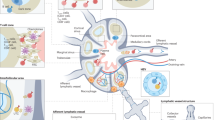Abstract
The immune system is tasked with detecting and responding to infections anywhere in the body. To accomplish this task requires the coordinated migration of immune cells and highly dynamic interactions of the migrating cells with their environment. Lymph nodes play a central role in this process by acting as local filter stations that prevent the spread of invading microbes and by providing a sophisticated environment to initiate and regulate innate and adaptive immune responses to antigens derived from pathogens, malignant cells and vaccines. To this end, lymph nodes harbor specialized antigen presenting cells and constantly recruit diverse lymphocyte subsets that engage in continuous immune surveillance and mount protective effector and memory responses.
You have full access to this open access chapter, Download conference paper PDF
Similar content being viewed by others
The immune system is tasked with detecting and responding to infections anywhere in the body. To accomplish this task requires the coordinated migration of immune cells and highly dynamic interactions of the migrating cells with their environment. Lymph nodes play a central role in this process by acting as local filter stations that prevent the spread of invading microbes and by providing a sophisticated environment to initiate and regulate innate and adaptive immune responses to antigens derived from pathogens, malignant cells and vaccines. To this end, lymph nodes harbor specialized antigen presenting cells and constantly recruit diverse lymphocyte subsets that engage in continuous immune surveillance and mount protective effector and memory responses.

Our laboratory has developed intravital microscopy techniques that allow us to identify and track the intra- and extravascular trafficking and dynamic interactions of different immune cell subsets within lymph nodes of anesthetized mice. Using fluorescence imaging strategies, we have traced the dissemination of invading bacteria and viruses via the lymph and analyzed how lymph-borne pathogens are handled upon entering a lymph node. We have characterized how pathogen-derived antigens are presented to T and B lymphocytes and how the in vivo kinetics of antigen recognition impact anti-microbial immunity and the formation and quality of immunological memory.



This lecture will provide an overview of our lymph node imaging strategies and summarize key insights that have been gained from their use to dissect the mechanisms and consequences of the multi-facetted immune responses to infections.



Author information
Authors and Affiliations
Corresponding author
Editor information
Editors and Affiliations
1 Supplementary Electronic Material(s)
(MP4 878075 kb)
Rights and permissions
Open Access This chapter is licensed under the terms of the Creative Commons Attribution 4.0 International License (http://creativecommons.org/licenses/by/4.0/), which permits use, sharing, adaptation, distribution and reproduction in any medium or format, as long as you give appropriate credit to the original author(s) and the source, provide a link to the Creative Commons license and indicate if changes were made.
The images or other third party material in this chapter are included in the chapter's Creative Commons license, unless indicated otherwise in a credit line to the material. If material is not included in the chapter's Creative Commons license and your intended use is not permitted by statutory regulation or exceeds the permitted use, you will need to obtain permission directly from the copyright holder.
Copyright information
© 2020 The Author(s)
About this paper
Cite this paper
von Andrian, U.H. (2020). Visualizing the Immune Response to Infections. In: Toyama, Y., Miyawaki, A., Nakamura, M., Jinzaki, M. (eds) Make Life Visible. Springer, Singapore. https://doi.org/10.1007/978-981-13-7908-6_16
Download citation
DOI: https://doi.org/10.1007/978-981-13-7908-6_16
Published:
Publisher Name: Springer, Singapore
Print ISBN: 978-981-13-7907-9
Online ISBN: 978-981-13-7908-6
eBook Packages: Biomedical and Life SciencesBiomedical and Life Sciences (R0)




